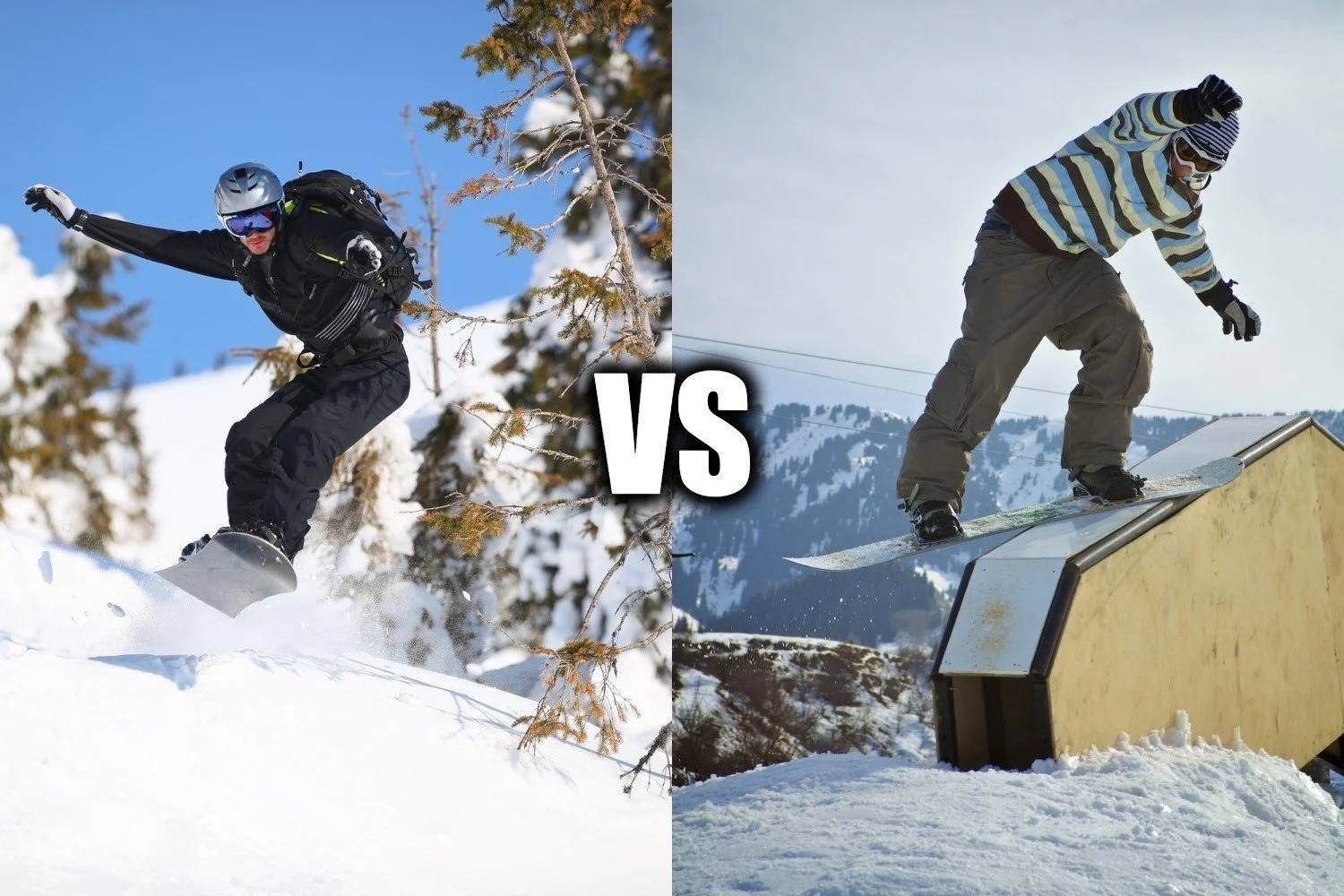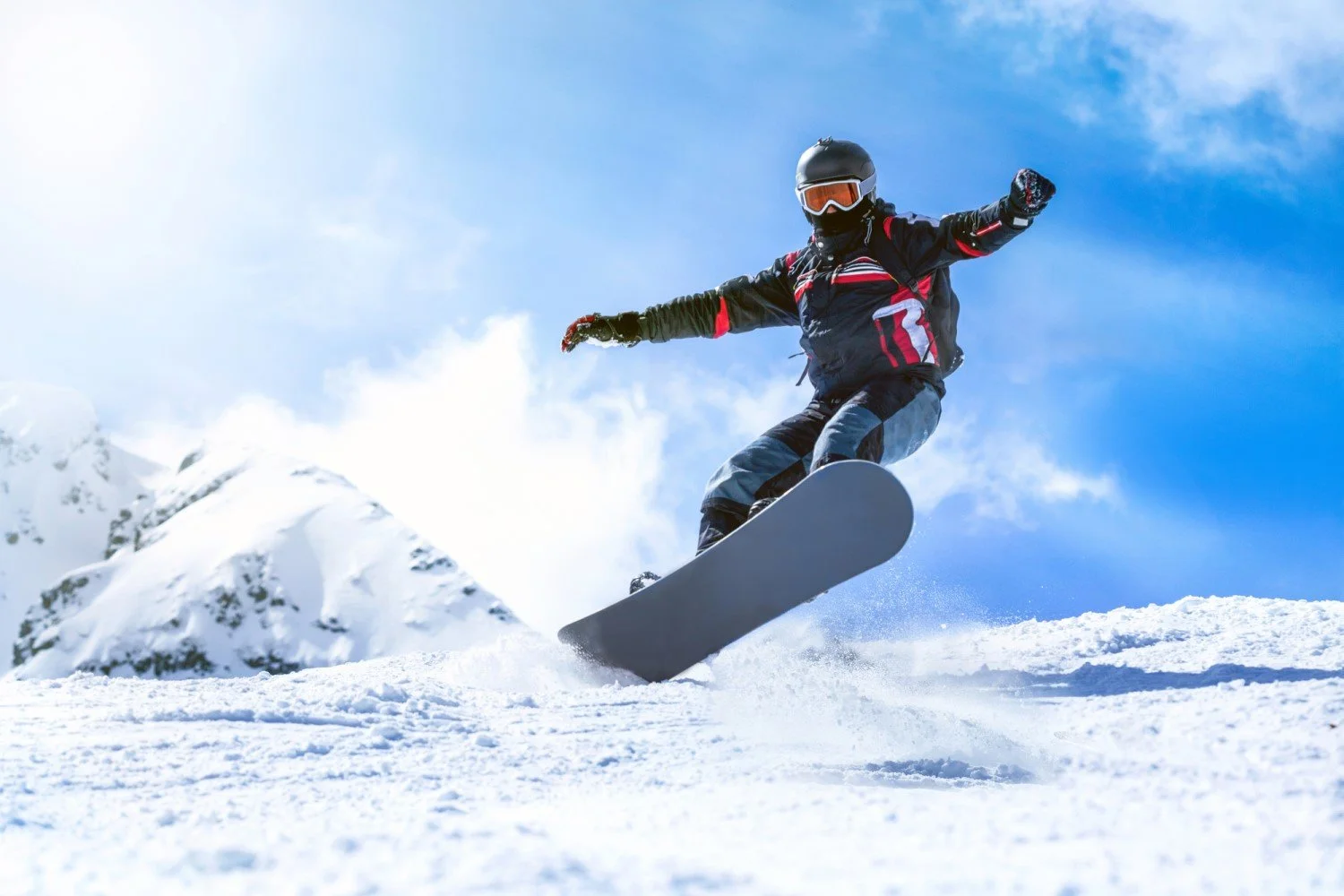Ultimate Guide to the Different Types of Snowboards
JUMP TO: COMMON QUESTIONS | ALL-MOUNTAIN SNOWBOARDS | FREESTYLE / PARK SNOWBOARDS | FREERIDE SNOWBOARDS | POWDER SNOWBOARDS | SPLITBOARDS | GLOSSARY
Author: Holly Price | Updated: Feb 25, 2023
We may earn a commission when you buy through our links. Learn more.
Whether you’re just getting started at snowboarding, or you’re looking to change up your riding style, it’s super helpful to have a basic understanding of the four main different types of snowboard, and what kind of rider they are designed for.
While there are tons of different boards out there, and sometimes the exact category they fall within is up for debate, understanding their different designs and characteristics will enable you to determine what style is best suited to your riding.
After you’ve decided on what style you’d like to invest in, you’ll also need to figure out what size, shape, profile, and binding set-up results in the best snowboard for you, but this gets easier after familiarizing yourself with each of the four snowboard types.
Before we get started with that here though, you might want to jump to the brief glossary, which explains some of the terms you’ll see throughout this article.
COMMON QUESTIONS
What are the main types of snowboards? There are five main types of snowboards: all-mountain snowboards, freestyle (also known as park) snowboards, freeride snowboards, powder snowboards, and splitboards. We describe each in more detail below.
What is the best type of snowboard for a beginner? The best type of snowboard for a beginner is generally an all-mountain or freestyle/park snowboard. These provide the most flex – meaning they are less responsive and more forgiving. They also have a true twin or directional twin shape – providing more versatility than specialized directional boards.
What is the difference between freeride and all-mountain snowboards? All-mountain snowboards are designed to handle everything – groomed trails, backcountry, park. Being a jack-of-all-trades, they usually do everything well, but nothing great. Freeride snowboards are specialized boards for advanced, aggressive riding in the backcountry – they are generally stiff and super responsive, and usually designed to be ridden in a single direction (not switch).
ALL-MOUNTAIN SNOWBOARDS
TYPICAL FLEX: Medium — Stiff (approx. 5 – 7)
TYPICAL SHAPE: True Twin, Directional Twin
KEY CHARACTERISTICS: All-mountain snowboards are designed to ride in any type of terrain, in any condition. Carving, trees, powder — anything is possible. If you hear someone talking about a “one board quiver”, they are likely talking about an all-mountain board. They usually do everything really well, but nothing great.
As you’d expect from such a jack-of-all-trades approach, all-mountain boards come with some compromises that prevent you from really going all out in mastering one type of riding style. This could, for example, be that your all-mountain board is just a little bit too stiff to really get the flex on those flatland freestyle tricks you’ve been trying to nail. Usually, an all-mountain snowboard will have a medium to stiff flex rating to give you a combination of both stability and freedom.
They often have a true twin or directional twin shape – the latter implying a very slightly longer nose than tail, which means it will favor one particular direction. Nonetheless, even a directional twin shape can be ridden in switch (albeit slightly less comfortable than a true twin).
There is a widely popular subcategory within the all-mountain style called all-mountain freestyle. This type of board is geared toward those who want a decent all-rounder, but with a premium freestyle and park element.
BEST SUITED FOR: An all-mountain board is suitable for someone who likes doing a little bit of everything, without going too hard in one particular area. An all-mountain snowboard is also a great option if you’re looking for a one board quiver worth investing in, or want to try the different types of snowboarding without having to fork out for four different boards.
FREESTYLE / PARK SNOWBOARDS
TYPICAL FLEX: Soft (approx. 1 – 5)
TYPICAL SHAPE: True Twin
KEY CHARACTERISTICS: A freestyle or park snowboard is designed for those who spend most of the season completing hot park laps, laying down their skills in jibs and jumps.
A freestyle board often has a symmetrical shape, which means if you were to fold the board perfectly in half, it would match up. What this means is that the rider can navigate seamlessly into switch riding, making tricks much easier.
The flex will also be symmetrical and loose, which means the board isn't engineered to drive the rider in a particular direction and bends easily, which is essential for those impressive nose and tail presses, tripods, butters, and other tricks that require a flexible board.
BEST SUITED FOR: Freestyle boards are suitable for most beginners thanks to their soft, forgiving flex and versatility. They also work well for those who want to ride switch and hit the park to master jibs and spins on boxes and rails. Freestyle boards are not great for aggressive carvers, because the softer flex means this style of board will usually become “chattery” at high speeds and doesn’t offer a great deal of stability.
FREERIDE SNOWBOARDS
TYPICAL FLEX: Stiff (7+)
TYPICAL SHAPE: Directional Twin, Tapered Directional, Directional
KEY CHARACTERISTICS: Freeride boards are made for aggressive carving, riding at top speed, and are often geared towards powder conditions too. A lot of directional features will be built into the design of a freeride board such as a tapered shape, set-back stance, and a stiffer flex for stability.
Freeride boards are often chosen by those who want to reach extreme, athletic levels of snowboarding which is why they are designed to be hyper-responsive, meaning however the rider moves their body will have an instant impact on what the board is doing.
BEST SUITED FOR: Freeride boards cater to experienced riders who want to blast pillows in the backcountry and charge hard when it’s steep and deep. Due to their advanced features and hyper-responsiveness, this kind of board definitely isn’t for a beginner rider - it’s safe to say you’ll spend more time catching an edge than riding.
POWDER SNOWBOARDS
TYPICAL FLEX: Medium — Stiff (6+)
TYPICAL SHAPE: Tapered Directional, Directional, Swallowtail, Fish
KEY CHARACTERISTICS: The aim of the game with powder boards is to float. While you can still use them for other types of riding, the experience you get in powder is going to be unmatched.
Powder boards are the most directional type of all snowboard designs, and they are usually wider too. This all gives you extra buoyancy and often pushes snow off the nose with subtle, scoop-like shapes. Powder snowboards will often have virtually no tail, which is why many of them feature a “fish” or “swallowtail” shape.
On a powder board, you’ll have a setback stance to help with maneuverability and to push your weight to the back of the board. This prevents your nose from buying into the deep stuff. Many riders often use their back legs for control and steering in deep powder, which is why this setback stance is so important.
The camber and flex will also be engineered to keep the nose up and tail down, giving powder hounds the control and comfort they need.
BEST SUITED FOR: Powder snowboards are suited to those who are constantly keeping a keen eye on the forecast and know all about those secret sweet spots of endless fluffy stuff. Essentially, if you live somewhere that has frequent snowfall throughout the winter season and you enjoy slashing through powder fields and between the trees, it’s definitely worth investing in a powder board.
SPLITBOARDS
If you love the idea of earning your turns, or getting to the top of the hill in time for sunrise and cruising down before the lifts have opened, then splitboarding might be the type of riding for you.
Splitboards, as the name suggests, are essentially snowboards that can be split into a pair of skis. The split part is for hiking up the mountain, when you’ll also need touring skins to give you the required friction on the ascent. Once you reach the top, you’ll be able to admire the view, have a snack and then peel off the skins, then fix your board together before cruising down.
It’s essential that you have an in-depth knowledge of the area, and have completed all of your avalanche and safety training before you attempt any backcountry splitboarding, but inbound splitboarding is perfect for those in-resort hikes.
We won’t get into the nitty-gritty of splitboards here. For now, just know that a splitboard feels a lot different from riding a regular board, thanks to the join running down the entire center of the board. You should preferably have some experience with snowboarding before venturing into the splitboarding realm.
GLOSSARY
FLEX: The flex rating of a board is how stiff or flexible it is. On most buying guides and board descriptions, flex is rated from 1-10. Between 1-5, you have your more flexible, freestyle boards. Between 5-7 are the all-mountain types that offer a little bit of both, while boards with a flex rating of 7 and upwards will be the stiffest kind, designed for hard carving and aggressive riding.
STANCE: The stance of a snowboard marks the points where your bindings will be fixed to the board. This is usually customizable to a certain degree, meaning you’re able to slide your bindings further towards the nose or tail of the board but only within the limits of the board’s design. Freestyle boards will have a more central stance, whilst powder and freeride boards will have a more setback stance.
PROFILE: The profile of the board is also known as how much camber it has. If you were to lay a snowboard on a flat surface, a traditional camber board will rise slightly at the center, and you’ll be able to feel the “pop” as you press down and release. Different profiles are specifically engineered to prioritize certain performance characteristics, from jumps to how you can control the board.
SHAPE: The shape of a snowboard is its outline or silhouette. These vary dramatically across the different types of riding, but the most straightforward example is the “true twin” shape common in freestyle riding. A true twin shape is perfectly symmetrical which means the riding feels the same regardless of the direction you’re heading in. Other riding styles such as freeriding and powder will focus more on one sole direction, driving the board a certain way for stability, float, and maneuverability.
JIB: A jib is a form of jump, trick, or slide that a rider does while snowboarding that makes their riding look all the more impressive. It’s a useful catch-all phrase for most small tricks you can complete on a snowboard.
SWITCH: In snowboarding, you’re either “regular” or “goofy” footed. Regular riders lead with their left foot, while goofy riders lead with their right. Switch riding is where you ride down the mountain leading with your alternative foot. This is an important part of progressing at snowboarding. Effective switch riding helps you land tricks, become more confident, and avoid colliding with other riders in tricky tight spots. The more symmetric shapes used for freestyle and all-mountain boards make riding switch easier, whilst the (tapered) directional shapes used for powder and some freeride boards will make riding switch harder and less comfortable.
MORE INFORMATION
Looking for more information on snowboarding and winter sports? Be sure to drop into some of our other relevant content:
Or see other articles in our Snowboarding 101 series:
Or check out our entire Gear Reviews Page, our Knowledge Base Articles, or Destination Guides for more snow and outdoors related content.


